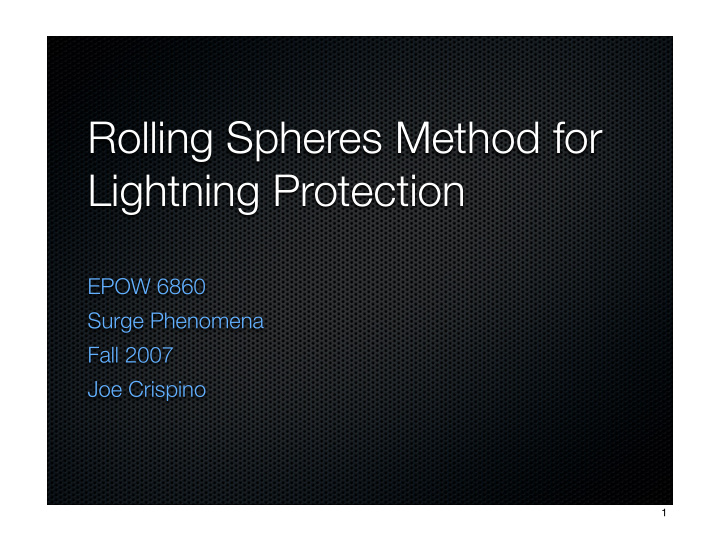



Rolling Spheres Method for Lightning Protection EPOW 6860 Surge Phenomena Fall 2007 Joe Crispino 1
Design Problems The unpredictable, probabilistic nature of lightning. Lack of data due to infrequencies of lightning strikes in switchyards. Complexity in analyzing system in detail ($$$). No known practical method of providing 100% shielding. 2
Design Procedure Risk Assessment Evaluate the importance and value of the facility. Consequences of a direct lightning strike. Location Frequency and severity of thunderstorms in area. Exposure due to surrounding area. Method of protection (surge arrestors, shielding). Evaluate the effectiveness and cost of design. 3
Design Methods Empirical Design Methods (Classical) Assume that the shielding device (wire or mast) can intercept all the lightning strokes arriving over the subject area if the shielding device maintains a certain geometrical relation (separation and differential height) to the protected object. 4
Design Methods Electrogoemetric Design Methods (EGM) Attractive effect of the shielding device is a function of the amplitude of the current of the lightning stroke. Less intense strokes get by. More intense strokes get intercepted. Only allow strokes that will not cause flashover or damage to protected object. 5
Design Methods Empirical Design Methods (Classical) - 69kV & below Fixed Angles Method (32.5%) Empirical Curve Method (12.6%) Electrogeometric Methods (EGM) - 345kV & above Rolling Sphere Method (16.3%) Mousa’s Software Subshield (21.1%) 6
Fixed Angle Method “Rule of thumb” method. Uses vertical angles to determine: Total number of protection devices. Position Height 7
Fixed Angle Method Independent of voltage, BIL, surge impedance, stroke magnitude, GFD, insulation flashover, etc. α is commonly 45°. β is usually 30°-45°. 8
Fixed Angle Method 9
Electrogeometric Model 1950’s - First 345kV transmission line. Protection utilized empirical methods. Outages due to lightning were much higher than expected. Led to extensive amount of research. E. R. Whitehead - EGM 10
Electrogeometric Model 1963 - Young, et al. - EGM 1973 - Whitehead & Gilman Most significant research. Only for transmission lines. 1976 - Mousa - Subshield program Integrated substations into EGM. 1977 - Lee - Rolling Sphere 11
Rolling Sphere Method Developed by Ralph H. Lee in 1977 for shielding buildings and industrial plants. Extended by J.T. Orrell for use in substation design. Builds on basic principles and theories from Whitehead. 12
Rolling Sphere Method Use an imaginary sphere of radius S over the surface of a substation. The sphere rolls up and over (and is supported by) lightning masts, shield wires, substation fences, and other grounded metallic objects that can provide lightning shielding. A piece of equipment is said to be protected from a direct stroke if it remains below the curved surface of the sphere. 13
Rolling Sphere Method 14
Rolling Sphere Method Requires: Surge impedance ( ). Z S Allowable stroke current ( ). I S Used to calculate striking distance, . This S determines the spheres radius. 15
Rolling Sphere Method ! 2 h $ V C R ln 0 & ' = # C R E " % C 0 ! 2 h $ 2 h ! $ Z 60 ln ln = # & # & S " % R r " % C Surge Impedance R Corona radius = C r radius of the condu uctor = h Average height of conductor = V BIL = C E 0 = Limiting corona gradiant, 1500 kV m 16
Rolling Sphere Method ( ) = ( ) 1 1 . BIL 2 2 . BIL = I S Z Z S S 2 Stroke Current ( ) ( ) 0 94 . CFO 1 1 . 2 068 . CFO = = I S Z Z S S 2 17
Rolling Sphere Method Strike Distance - the = 0 65 . S 8 kI probability of the stroke m = 0 65 . tip terminating on an S 26 25 . kI f object S far away is greater than the = probability of it striking k 1 Ground or Wir res another object S+n k = 1 2 . Lightning Masts away. 18
Rolling Sphere Method 19
Rolling Sphere Method BUT WAIT!!!!! What if the actual stoke current is greater than calculated? 20
Rolling Sphere Method What if the stroke current is less? As long as the stroke current was calculated using the BIL of the equipment, the equipment will be protected. 21
Rolling Sphere Method 22
Rolling Sphere Method 23
Rolling Sphere Method 24
References IEEE Std. 998-1996. IEEE Guide for Direct Lightning Stoke Shielding of Substations . Greenwood, A. Electrical Transients in Power Systems . Abdel-Salam, M., et al. High Voltage Engineering - Theory and Practice . Zipse, D. Lightning Protection Systems: Advantages and Disadvantages. IEEE Transactions on Industry Applications, Vol. 30, No. 5, September/October 1994. 25
Recommend
More recommend